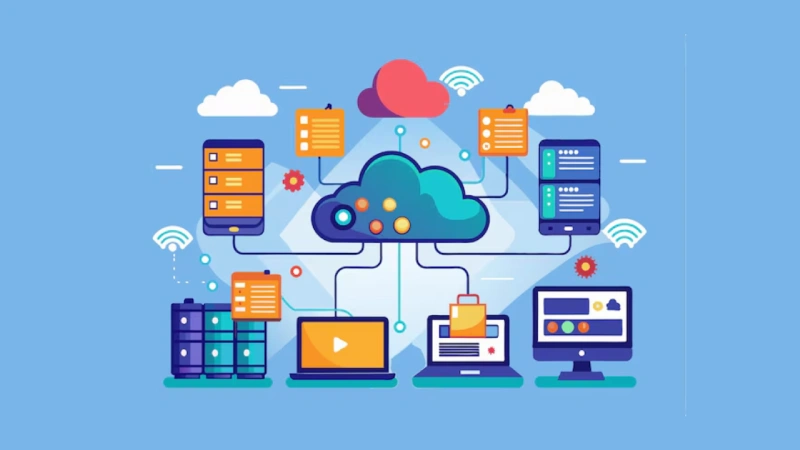Cloud Computing is a network or server accessed over the internet ( present at a remote location). In Cloud computing data can be stored at various remote locations. It means storing, managing, and accessing the data on the remote server that is hosted on the server instead of on a computer hard drive.
Cloud Computing is the on-demand availability of computer system resources (especially data storage, cloud storage, or any virtual machine without direct active management by the user. One of the major benefits of cloud storage is provides secure ,flexible and scalable solutions for data management.

There are several types of service providers, including Google Cloud, AWS (Amazon Web Services), Azure, IBM Cloud, and Alibaba.
Types of Cloud Computing
- Public
- Private
- Hybrid
- Community
This article will discuss Cloud Computing, Cloud Application Services , Cloud Migration Strategies, its types, Cloud Computing Models, Benefits of cloud computing, challenges etc in detail.
Brief History and Evolution of Cloud Computing
Cloud computing has evolved significantly over the years:
| Years | Key development |
| 1960 | Conceptual foundations by J.C.R. Licklider on interconnected computers. |
| 1970 – 1980 | Launch of Timesharing Systems. It allows multiple users to access a central computer together. |
| 1990 | With the emergence of the internet, web-based applications began to make an appearance, revolutionizing the way we interact with technology. |
| 2002 | Birth of Cloud Services took place. Amazon launched EC2 in 2006, starting commercial cloud computing. |
| 2010 | Rapid Growth and Adoption as more businesses use cloud services for storage( like Dropbox ) and software as a service ( Saas). The focus also shifted to the Hyrid system. |
| 2020 | Cloud Computing integrates advanced technologies like AI and machine learning, improving automation and analytics, and making data processing secure and reliable. |
Characteristics of Cloud Computing
On-Demand Self Services
Users can add or remove any number of resources depending on their needs and resources can be added automatically to fulfill needed bandwidth for high traffic. This ensures reduced cost and scalability of services.
Broad Network Access
Services can be accessed from any location, any time using various devices like smartphones, tablets, and laptops to improve accessibility.
Resource Pooling
Resources can be storage, bandwidth, Networks, Virtual machines i.e. it can be any service that can be consumed by cloud users. Resource pooling means that multiple users are serviced from the same physical resources. This approach enables providers to reduce costs, leading to Cost Savings with Cloud Computing and offering benefits to users at lower prices for services. Customers can easily upgrade or downsize the resources as needed. By combining resource pooling with cloud virtualization, providers can deliver scalable, cost-effective solutions that meet the diverse demands of their clients.
Measured Services
You are only paying for the resources or the services as per use.
Rapid Elasticity and Scalability
One of the best things about cloud computing is you can quickly add or remove resources according to the organisation’s needs and provide flexibility to users.
Security
Cloud computing providers use advanced safety measures to secure data ,ensuring cloud data protection through various strategies. Copy of data on various servers if one fails data can be safe on the other servers. Organization can protect their data and prevent any cyber-attacks with cloud security best practices.
Advantages and Disadvantages of Cloud Computing

Mobile devices infographics with phone tablet and cloud computing elements vector illustration
Advantage of Cloud Computing
- Resources can be accessed anywhere or at any time.
- On-demand self-services that is there is no need for a third party.
- It reduces IT costs ( we do not need to buy hardware, no maintenance is require).
- It is highly scalable that if there is traffic on the website we can easily scale up and down the resource usage. “Pay as per use “
- Snapshots of the resources can be schedule at any frequency for backup purposes.
- It is easy to collaborate with multiple remote locations using common resources.
- It also helps to save time as we do not need to update the software and maintain the hardware.
Disadvantages of Cloud Computing
- Network connection dependency, we cannot access if we do not have internet so the internet is a must. Any disruptions in internet connectivity create problems in accessing cloud services which impacts productivity.
- Lack of support ( eg. unable to access data before meeting so it is essential to choose a provider carefully to face any problem).
- Not get all the features as all the cloud service providers are the same.
- Cost over time – At the initial stage cost may be low but due to unexpected usage charges, subscription fees make cloud solutions more expensive in the long run.
Types of Cloud Computing
There are four types of cloud computing.
Public Cloud
This type of cloud is available to everyone. It is open to all stores and access information via the public internet. It is managed by a third-party i.e. Cloud Service Provider. The fundamental Characteristic of Public Cloud computing is Multi-tenancy ( shared resources used by multiple users)
eg – Google Drive, iCloud ,EC2 ( Amazon Elastic Compute Cloud) It is available on AWS , Google App Engine
Pros of Public Cloud Computing
- It is maintained by a cloud service provider so we do not need to retain it.
- It is Cost-Effective.
- It is highly Scalable.
Cons of Public Cloud Computing
- It is less secure as resources are shared publically and can raise security concerns.
- It is less customizable than the private cloud.
- Limited Control.
Private Cloud
These services are accessible within the organization with great control and security. It belongs to a specific organization. It is managed by both third parties and organizations.
Pros of Private Cloud Computing
- High Security – In the Private Cloud, security concerns are less since customers’ data and information do not flow out from private infrastructure.
- Data Privacy– Only authorized people can access the data and information.
- Customization: It is highly customizable as compared to the public cloud as organizations get to customize their solutions as per the specific needs.
- It improves reliability.
Cons of Private Cloud Computing
The area of operation is limited as the private cloud is accessible only within the organizations.
- High Cost – It is costly as we need to invest in hardware and software
- Limited Scalability as compared to the public cloud
Hybrid Cloud
It contains features of both private and public cloud
Critical activities are performed by private and critical activities are performs by public cloud.
Pros of Hybrid Cloud Computing
- It is Highly Scalable
- It is high security.
- It is cost-effective.
- It is highly flexible.
Cons of Hybrid Cloud Computing
- Difficult to manage because there are more than one type of deployment model is use.
- Dependency on infrastructure.
Multi-Cloud Strategy
It allows services to be accessible to several organizations, enabling them to share information between the organizations and the community. It is managed and operated by a third party, one or more organizations in the community.
Pros of Multi-Cloud Computing
- It is cost-effective and cost reduction. It is cheaper than private cloud because there is a benefit in multi-cloud as multiple companies share the bill which will reduce the cost.
- It is more secure than the public cloud but less secure than the private cloud.
- It is highly flexible.
- It is reliable.
Cons of Multi-Cloud Computing
- Data is accessible between the organization because the data is store at the same locations any data stored might be accessible by others. This can result in overall security concerns about the rules and regulations to compliance within a community cloud.
- Consistency Maintenance cost.
- Increased Management Overhead.
Challenges in Cloud Computing
Vendor Lock-In: Navigating Provider Dependencies
Choosing a cloud provider is a daunting task for the organization as it vary on their needs and the environment they are use to throughout the oorganization. It is a situation where the customers are dependent ( locked in ) on a single cloud provider technology, and implementation and cannot easily move to a different vendor without substantial cost, legal constraints, and technical incompatibilities. This can result in limited flexibility and innovation as companies face many problems with one provider’s tools and pricing.
In simple terms, vendor lock-in means organizations face problems when transferring their services from one vendor to another. As different vendors provide different platforms and services, moving a cloud-based application from one cloud provider to another can be difficult and complex. Staying with a single cloud provider comes with several risks including rising costs, missed opportunities, and complex migration.
Types of Vendor-locked Risks
Data Transfer risks
It is not easy to transfer from one cloud service provider to another.
Application Transfer Risks
If we build one application on a cloud service provider that leverages many of its offerings, the reconfiguration of this application to run natively on another provider application can extremely expensive and difficult process.
For example – Suppose an application is built on Azure and we have used Azure data analytics and bot services we will have to make a lot of changes to the application because these services may not be there or can be different in other cloud service providers.
The reason for these challenges and difficulties arises due to a lack of standard interfaces and open APIs. Every cloud services provider has their own standard ,making it difficult for organizations to shift their cloud application development efforts seamlessly between different environments
Human resources knowledge risks
if we are working on one cloud service provider our developer teams have gained a lot of knowledge about that provider’s tools and configurations. But if we move from one cloud service provider to another one, the team will require more effort to learn all the Cloud Computing Tools, implementation, and configuration which will impact the cost and time.
Real-World Applications of Cloud Computing
There are various applications of cloud computing some of them are mention below.
Business Application
Nowadays every business needs cloud computing to drive growth in their business . Enterprise cloud applications than can improve productivity, scalability, and flexibility , improved collaboration with in the organizations. There are a few business applications of cloud computing like Paypal( It is a safe payment mode ) salesforce(provides tools for e-commerce, sales, etc) Razorpay (online payment gateway).
Data Storage and Backup Application
We can store files, data, messages, images, audio, and videos eg – on Google Drive. Onedrive.
Education Application
Digital Transformation in the education sector has significantly improved the learning process and assisted many people in learning remotely. Cloud is one of the modern accessible tools that also help in online distance learning. There are various cloud computing service providers are available.
For Example – Google Documents (a Service Provided by Google) ,Chromebook for Education, AWS in Educations
Entertainment Application
Cloud computing offers various game-changer entertainment applications like online games, video conferencing apps, streaming, and online music/videos.
Art Application
Cloud computing offers various art applications for quickly and easily designing attractive cards, booklets, and images.
Example
Moo – A cloud art application that is use to design business cards.
Adobe – It is a creative tool use for graphic and web designing.
Social Application- It allows millions number of users to connect.
Some examples of cloud-based social media apps include Facebook , Yammer, Twitter, and LinkedIn.
Future Trends in Cloud Computing
- AI and Machine Learning Integration.
- Rise of Edge Computing.
- Enhanced Security Measures.
- Hybrid and Multi-Cloud Adoption.
- Focus on Data Privacy Regulations.
- Blockchain in Cloud Services.
- Adoption of DevOps practices
Conclusion
Addressing cloud computing challenges is important for maximizing benefits.
Key Issues to Tackle:
- Vendor Lock-In
- Data Privacy Concerns:
- Connectivity Problems.
To achieve long-term success in the cloud, organizations should adopt a strategic approach that includes: Align cloud services with business objectives and needs. Teams need to maximize the effort to learn about all the cloud automation tools, implementation, and configuration when transferring one cloud service to another. Use of robust measures for data security and applications.
Regular monitoring of cloud usage is need to manage cost expenses efficiently. Implementing all these strategies helps organizations navigate cloud complexities, foster innovation, improve operational efficiency, enhance security, deliver high-quality products and services to the users.With DigiTrend Marketing’s cloud computing services, businesses can harness the power of the cloud to improve efficiency, enhance security, and reduce operational costs. Let us help you navigate your cloud journey!



